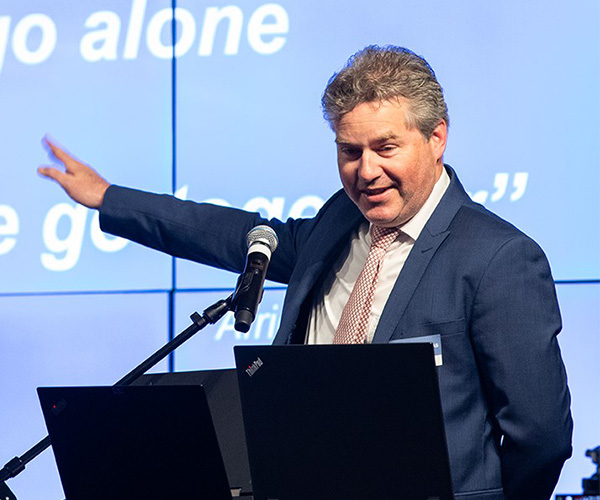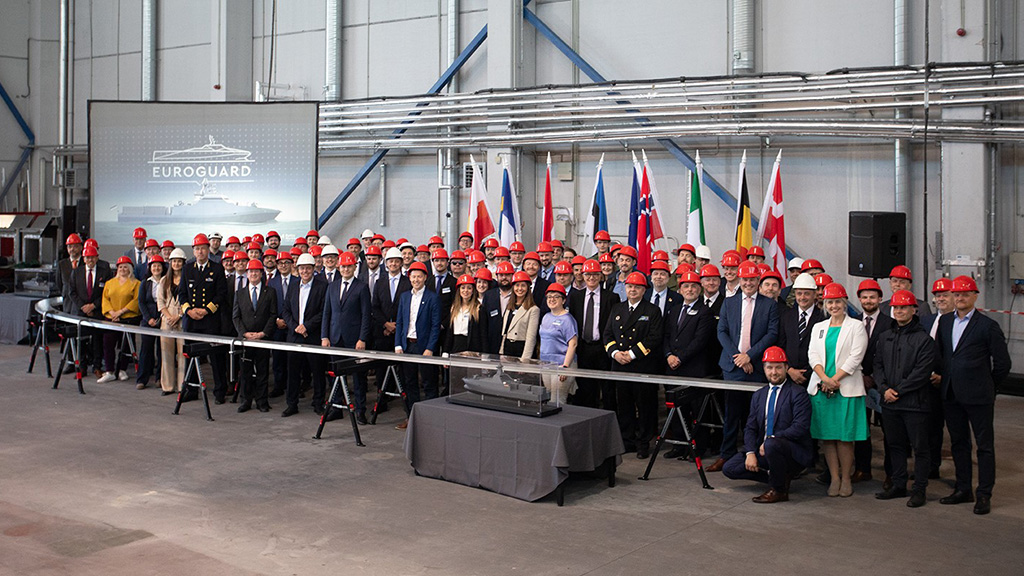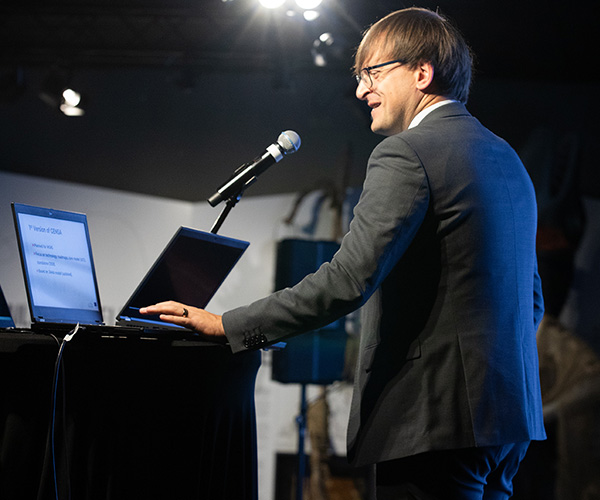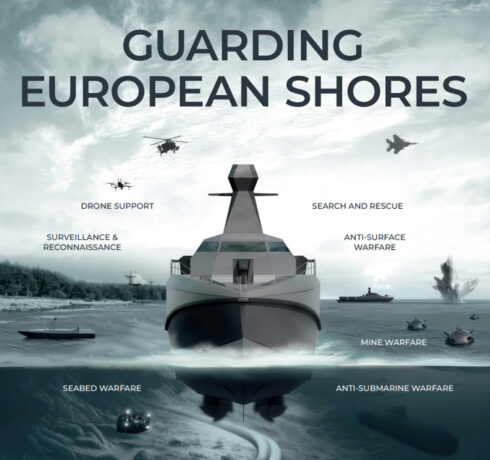Damen Naval is part of EUROGUARD: a project that is building a vessel capable of a range of different autonomous operations in coastal areas. Funded by the European Defence Fund (EDF), this represents a collaboration between 23 companies from ten EU Member States. The EUROGUARD project started in December 2023.
With the recent passing of a major milestone – the keel-laying of a 45-metre MSAS (Medium-size Semi-Autonomous Surface vessel) on 27 May at Baltic Workboats in Estonia – it’s time to learn more about Damen Naval’s involvement in the EUROGUARD project from the company’s Project Manager RD&I Marcel Elenbaas and Process Architect Koen Droste. Marcel is project managing the Dutch scope of EUROGUARD; Koen is the technical lead for the project’s system architecture.
 Marcel Elenbaas.
Marcel Elenbaas.
The MSAS: a vessel representing European collaboration
Marcel begins by describing the first and most tangible of the project’s deliverables. “This is the MSAS, the demonstrator platform that will be built, tested and validated,” he says. “This will be a semi-autonomous vessel, meaning that it still has crew on board, but where possible the systems function autonomously or remotely controlled, depending on the mission and weather conditions. The function of these systems can be taken over by personnel on board or off board if necessary.”
Crucially, the MSAS is the first of its kind. “It’s not a reshaping of a patrol craft, for example. It’s a completely new type of vessel,” clarifies Marcel. “Furthermore, it signifies a new type of collaboration of European member states, involving many shipyards and technology providers. Because this is a new way of creating a new type of vessel, this calls for a new type of design architecture.”
Introducing GENSA
This new kind of design architecture is how Damen Naval is participating. That’s because, contrary to what you have maybe assumed, Damen is not actually building the MSAS. Instead, Damen is creating a generic architecture. “This is called GENSA: the Generic European Naval System Architecture,” notes Koen. “This is the methodology to develop and build these vessels that will help us define better specifications together with clients for the next generation ships. It is a way of thinking that can be explained as a better understanding of the problem before diving in to find a solution.”
“If we first developed the architecture, and then the vessels, the project would take twice the time. And secondly, by working in parallel, we don’t miss out on any new technologies that are under development during the project.” Koen Droste
Koen expands on GENSA: “These developments pursue two goals, firstly we aim to provide a method that connects a client’s requirements to an architecture defined for MSAS type systems. This helps standardise and streamline this process amongst the clients, in this case European member states. Secondly, the GENSA provides a roadmap element in which, for that standardised architecture, we will capture the development of new capability and technology over time. These developments are already happening within this project.
The combination of the two is crucial, as it will not only make it possible to connect requirements to an architecture to improve the definition of these requirements. But being connected to that architecture, it will explore the available technology as captured in these roadmaps to provide a quick insight in the latest possibilities the industry has to offer.
 Team photo at the keel laying ceremony on 27 May 2025.
Team photo at the keel laying ceremony on 27 May 2025.
To top it off, we are also extending the architecture with methodology to explore these designs in a more automated fashion using ship synthesis models and trade space exploration techniques. “All in all, it’s quite a package of functionality to speed up innovation by making it easily available and to foster collaboration by providing this common collaboration platform. These developments are fully ongoing at the moment as only this February we reached the milestone that defined the design of the GENSA. That is the structure of the architecture and the key elements within that. Reaching that milestone for such an abstract topic as this within such a large consortium on time is really a key performance of the team we working with in this project.”
The two deliverables of the EUROGUARD are moving in parallel. Why is this? “If we first developed the architecture, and then the vessels, the project would take twice the time. And secondly, by working in parallel, we don’t miss out on any new technologies that are under development during the project,” replies Koen.
 Koen Droste.
Koen Droste.
Alignment & interoperability
From the perspective of pan-European cooperation, the creation of GENSA is significant in two distinct ways. The first is that “within Europe, we need to improve the interoperability and alignment between navies, but meanwhile the various navies operate in quite different areas” says Koen. Indeed, Baltic operations have different requirements to, for example, naval activities in the Mediterranean. “The fact that these vessels are designed to do a large range of activities on various types of missions, demonstrates the importance of ensuring alignment and interoperability between the platforms where possible,” says Koen continues.
Marcel continues: “With GENSA, we can align these different concepts of operations: the CONOPS. We can distinguish what is similar in all these nations, and we can identify the differences due to geographical areas or whatever reason. And that means that we can be very specific, working together in Europe to harmonise requirements and solutions.”
Mission modularity
The second benefit of Damen Naval’s work on GENSA is related to the rapid pace of technological developments. “The idea of Gensa is to provide a solution between the various member states and their navies,” explains Koen. “The industry is able to push new technological developments, and member states can facilitate the incorporation of new standards into these designs.”
“With GENSA, we can distinguish what is similar in all these nations, and we can identify the differences due to geographical areas or whatever reason. And that means that we can be very specific, working together in Europe to harmonise requirements and solutions.” Marcel Elenbaas
“This involves systems modularity and therefore mission modularity; understanding the needs of different member states,” add Marcel. “This calls for different mission modules with specific capabilities. To have those ideas combined into one methodology, one generic architecture that is GENSA, is really adding value towards these European naval developments.”
Another first: a shared requirement management system
Besides Damen’s work on GENSA, the EUROGUARD project exhibits another ‘first’ for the European defence industry. This is the creation and implementation of a shared information management system. “We are collecting all the information from the EUROGUARD project and assembling a big model out of that using the platform called JAMA Connect. This allows us to keep things up-to-date easier and faster. And to provide the proper views of the model for the specific stakeholders,” says Koen. “To the best of my knowledge, this is the first and only EDF programme that runs a shared requirement management system. Having a model in which around 180 members can work together in a more digital manner is quite an achievement. We at Damen have been quite instrumental in getting the JAMA platform up and running.”
And finally…
A good way to illustrate the collaborative nature of the EUROGUARD is to take a look at the project workshops – typically two-day events – that have been held every six months since the project’s launch. “These workshops are more than just listening to PowerPoint presentations – they are democratic and interactive sessions with discussions about requirements, solutions, and about how various technology areas are approaching the next phase of the project. That really shapes the collaboration; it really is unique,” says Koen.
“The workshops are a good way to get the member states involved; for them, collaborating on this type of project is new. It also gets all the technical people from different backgrounds – from propulsion to autonomy and cybersecurity – together in one room. Having these workshops together gives all project participants a better understanding of how to collaborate, Marcel concludes.

